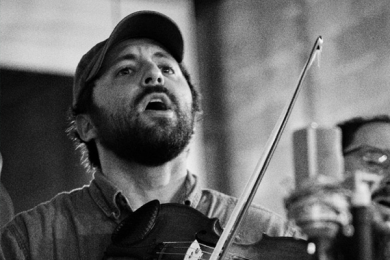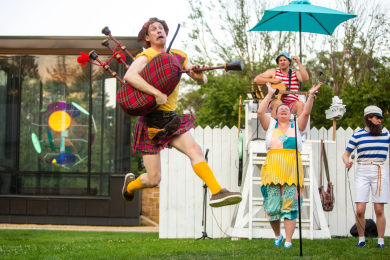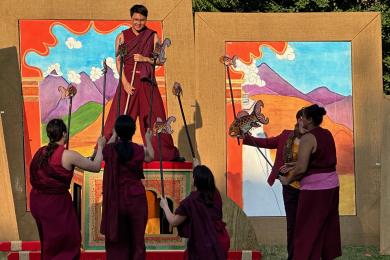Process, dance injuries, and theater break ups. News and notes for 5.30
News
I saw an interesting improv show at HUGE theater this past weekend that I want you to know about. It’s called Process. The way the show works is that a group of improvisors create a play live on stage. They start at the table read, then move to rehearsals, and finally the performance. The catch is that every element is completely improvised.
The performers start out holding scripts that are just blank pieces of paper stapled together. The play has a director, portrayed by an improvisor, and the other performers slowly figure out which role or roles they’re playing in the play. It’s a rather complex improv structure with a lot of room for games but also a lot of room for missteps.
I think this is a show that would appear to people who love improv but also people who love staged plays. It's fun and there's risk and if all goes according to plan there's a payoff. So I suggest you go and bring a friend to see a play that will exist only for the 50 minutes as its being created in front of you.
Performances of Process take place on Fridays at 9:30 at HUGE theater in Minneapolis.
--------
Are there parts of your work with which you have a complex relationship? I have a weird, ex-girlfriend like relationship with improv comedy theater.
My first love as an artist and as a performer was improvised comedy. The first time I ever stepped on a stage was to learn improv and the first time I ever performed in front of an audience was to do improv. Both moments were strange and awkward and full of excitement and joy. I had given no thought to being a theater artist before I started taking improv classes and two years later I was performing 6 or 7 nights a week and giving no thought to being anything but an improvisor.
Anyone who has performed for a live audience knows that high of getting and holding an audience’s attention. Anyone who has performed live comedy knows how that feeling can be amplified and even intensified by getting that audience to laugh. But there’s something more happening when that live comedy performance is completely improvised. Everyone involved, the performers and the audience, know how close each moment is to failure but no one wants it to go bad. This creates an intense feeling of risk tempered with optimism which literally sets the stage for theater magic.
That description makes me feel a little silly as I write it but the dynamic of live improvised comedy is like nothing else that happens on a stage. It was a dynamic I lived in and chased after for several years. Until I slowly came to the conclusion that no matter how hard I committed to improv it was never going to commit to me. We could have an amazing time together and it brought a great many wonderful things into my life but I could never look to improv for some of my essential needs like food, shelter, and most things that meant a safe and stable life.
So we broke up.
I stopped doing improv. I acted in plays with scripts and directors. I wrote stories and sketches. I took classes on writing. I read plays. I artistically diversified. I built relationships with other parts of the theater arts that had many of the things I loved about improv but also could offer some of the basic life stuff. And the relationship with writing and producing shows feels a lot more like work than doing improv ever did. The spark isn’t quite as strong, the risk isn’t quite as great but without those high highs the lows aren’t nearly as low either.
I wouldn’t say my break-up with improv was clean. I walked away completely at first because I couldn’t imagine doing improv just a little bit. Now, we still spend time together here and there. Occasionally, things get intense and feel like old times. Usually, though, I bump up against my own nostalgia and any joy is bitter sweet.
Have you ever broken up with a genre or field of artwork?
--------
I recently sent out a request for stories of dance injuries.
Tamara Ober just a few weeks ago experienced an encounter with a dance injury that will make you wince.
From Tamara:
Greg (dancer in Zenon) got injured on Saturday -- it was awful and kind of amazing. His bicep tore and curled up into a little ball - we had one show left on Sunday, and I do not understand, but the man is a freak of nature the way he deals with injury. He did the show the next day with a few choreographic alterations. It was astounding. And bizarre. I don't know how it's possible to not freak out with a body part literally detached and rolled up inside your skin, how it's possible to deal with that level of pain and be "fine" about it, and on a practical/functional level, how in the world it's even possible to do what we do without a bicep...??! I don't understand. It was inspiring. That's a short story of inspiration just for you! :) I could literally write a novel on injury. :p
Tamara Ober
Dancer, Choreographer, Teacher
--------
John Munger responded with this amazing story of injury and recovery.
From John:
When I was 28 and dancing with Colorado Dance Theater I landed a role as “Og the Leprechaun” in a production of the old chestnut musical, “Finian’s Rainbow.” This was in the 1970’s and Marley floors for dance had not yet been invented, so we were on true wood. I wore ballet slippers that had been modified and dyed to look like little green leprechaun booties.
In the next to last scene I had a song and an extended dance with “Silent Susan,” a character who expressed herself only through dance. Moments before, a character had hurled magical lizard dust into the air. It was talcum powder. I begged and begged the props and costumes departments of the production to use something other than talcum powder or to put me in footwear other than ballet slippers. To no avail. They poo-poohed the 28 year old kid. They knew better, right?
One night in the run I landed an elevation in the lizard dust and my feet went out from under me as if a rug had been yanked. When I hit the floor I dislocated my right shoulder. And it did not go back in. Let me tell you, the level of pain is exceptionally intense and usually causes instant clinical symptoms of shock, such as cold sweat, paling, disorientation, and fast shallow breathing. The Spanish Inquistion used to employ deliberate shoulder dislocation for their purposes. It’s unspeakably hideous.
Somehow I carried on and finished the scene. “Silent Susan” and I, old dance colleagues, whispered to each other sotto voce communications on how to improvise finishing the duet with me operating on only one arm. At the end of the scene I exited upstage right and nearly fainted. I finally got the arm back into its socket.
Two months later I underwent restorative shoulder surgery on a major scale. It took a year to recover fully. I spent eight weeks in a wraparound sling, then months and months working to be able to raise my right arm past eye level. A physical trainer worked with me, but after three sessions took a deep breath and said, “What you as a dancer know about how to rehabilitate your arm is better than everything I know. Go ahead with what you’re doing.” End of PT work and beginning of self-rehabilitation work.
Now, almost 40 years later, I am fully recovered except for a long and deep scar around my right shoulder area, and an oddity of movement limitation that no other dancer and no audience member would ever notice.
If I can recover from that, what can you do?
John Munger
Third Rabbit Dance
Dance Teacher at Zenon
Choreographer and dance/theater performer
--------
Got comments about this or anything else happening with Minnesota Playlist? Send message to [email protected]
I hope you have a week free from injury or heartbreak.
-Levi




